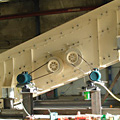WHAT ARE FEEDERS?
November 16, 2015
In a mining context, feeders are located at the origin point of the extraction process. If we were to send a flying camera zooming down to the vein of mineral, the coal face or ore seam, we’d see huge machinery scraping at the rocky face. The cut and drilled matter is still very coarse and raw, but it’s about to begin a journey. That journey will take the rough-hewn geological matter along kilometres of conveyors until it reaches the light of day and a transportation hub or processing station. The feeder stage is situated on the first leg of this chain. It combines a funneling function with other invaluable attributes.
EXPLAINING FEEDING MECHANISMS
As is standard in high-industry scenarios, versatility is a requisite part of mining technology. A basic feeder, for example, is simply built to be durable and to act as a guiding mechanism, a compact structure that channels the ore-laden rocks onto a conveyor. From here, the irregular matter is screened, dewatered, and generally graded as it chugs along through chambers and tunnels toward the surface. This functionality also applies to above ground operations, of course, but, for this example at least, we’ll use a subterranean model. Depending on the mobile mining machinery and the type of rock being excavated, additional elements tend to be added to feeders. There are breaker models, a type that chops the rock into a finer form before passing it forward. Grizzly feeders handle the heaviest grades, positioning inflexible steel bars in the rough flow to manage heavy loads.
BRUTE FORCE VERSATILITY
Manufactured as pan fed or vibratory fed mechanisms, innovative versions of the design are considered a key part of a productivity cycle, mostly due to the fact that this is the origin point of the process, the point where all conveyors and screens roll outward. If this part of the process isn’t functioning at peak efficiency, then every other stage will suffer. As a consequence of this realization, this primary supply platform must meet the needs of the mine. It has to be built tough, able to deliver a high capacity of raw material, and all of this beefy functionality must be achieved without sacrificing system reliability.
Like the man-powered shovels of yesteryear, the primary function of these material supplying behemoths is to get just mined rock moving. Modern variants accomplish this task with snappy efficiency, never wavering under the impact of abrasive forces. But they also incorporate enhanced features, including vibratory subsystems, secondary decks, and low maintenance moving parts, wrapping every assembly in an inviolable casing of high-tensile steel. They “eat” up rock and aggregate matter, delivering primary control to a chain of stages that extends for kilometres.
Screening Technology Pty Ltd T/AS Hawk Machinery
Address: 7 Lantana St Blackburn North Vic 3130
Contact Person: Bohdan Blaszczyk
Phone: +61 3 9877 7777
Fax: +61 3 9877 8177
Mobile: 0411 099 989
Email: info@hawkmachinery.com.au
Optimized by NetwizardSEO.com.au
Optimized by: Netwizard SEO


